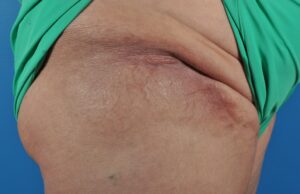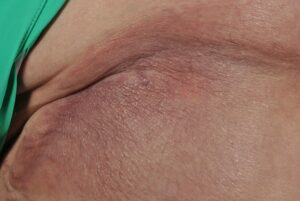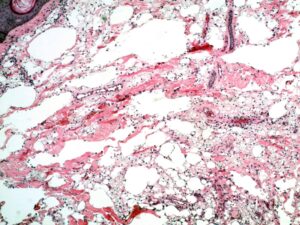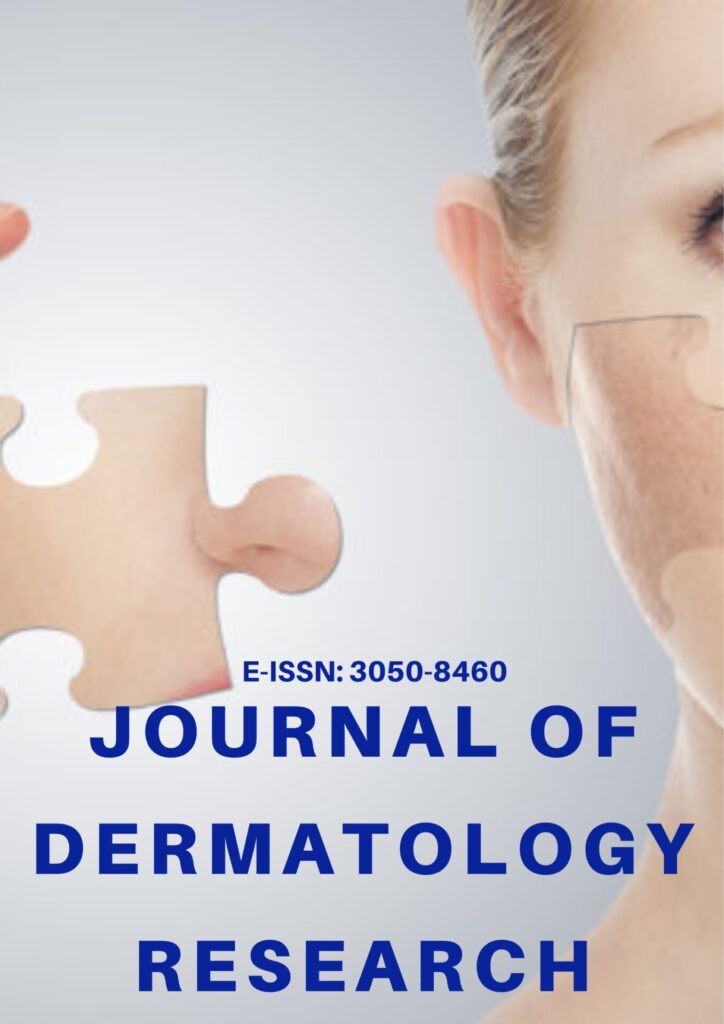Case Report | Vol. 6, Issue 1 | Journal of Dermatology Research | Open Access |
Silicone Granulomas: The Good, the Bad, the Ugly
Curt Samlaska1*, Bradley Boman2
1Assistant Professor of Medicine, University of Nevada School of Medicine, 2839 St. Rose Parkway, Suite 100, Henderson, NV 89052, USA and Assistant Professor of Medicine, Touro University Nevada, 874 American Pacific Dr. Henderson, NV 89014, USA
2Touro University Nevada, 874 American Pacific Dr. Henderson, NV 89014, USA
*Correspondence author: Curt Samlaska, MD, FACP, FAAD, Assistant Professor of Medicine, University of Nevada School of Medicine, 2839 St. Rose Parkway, Suite 100, Henderson, NV 89052, USA and Assistant Professor of Medicine, Touro University Nevada, 874 American Pacific Dr. Henderson, NV 89014, USA; Email: [email protected]
Citation: Samlaska C, et al. Silicone Granulomas: The Good, the Bad, The Ugly. J Dermatol Res. 2025;6(1):1-6.
Copyright© 2025 by Samlaska C, et al. All rights reserved. This is an open access article distributed under the terms of the Creative Commons Attribution License, which permits unrestricted use, distribution, and reproduction in any medium, provided the original author and source are credited.
| Received 19 December, 2024 | Accepted 12 January, 2025 | Published 19 January, 2025 |
Abstract
Liquid Injectable Silicone (LIS) has become a widely utilized material in various cosmetic interventions such as body contouring and enhancement. While these applications often yield positive aesthetic and functional outcomes, the use of silicone is not without risks, earning an FDA warning. This cautionary stance prompts some patients to seek LIS treatment from unlicensed practitioners inside and outside of the US. Adverse effects of LIS use can vary, from infections, necrosis and embolization. Silicone-induced granulomas, though infrequently reported, represent a challenging complication that can manifest in the aftermath of cosmetic procedures acutely and many years later. This case report aims to contribute to the growing body of literature on silicone-induced granulomas by presenting a unique clinical case.
Keywords: Liquid Injectable Silicone; Rash; Biopsy; Silicone Injections
Report of a Case
A 64-year-old female presented for evaluation of a “rash” involving both legs and proximal thighs. The eruption began a few weeks before her appointment and she noted a “burning sensation” in the affected areas. She reported a history of silicone injections performed approximately 30 years ago in Mexico by a medical professional. The patient was instructed to purchase cans of medical-grade silicone from a drug store [1-5].
She had three sessions, injecting into her hip and thigh regions. She states she was very thin and had bony hips and the injections softened her appearance. Her past medical history was remarkable for hypertension, heart disease and rheumatoid arthritis. Her medications were diovan, pravastatin, Excedrin, provera and Wellbutrin.
On clinical examination, there was dramatic reddish brown colored indurated plaques involving both hips and proximal thigh regions (Fig 1). Along hip regions, there were 1-3 mm bluish papules with a pseudo-vesicular appearance (Fig 2). A punch biopsy was performed.

Figure 1: Right hip demonstrating reddish brown indurated plaques.

Figure 2: Bluish papules along the left hip regions coalescing into plaques.
On histology the biopsy demonstrated multi-vacuolated histiocytic cells, both scattered individually and in aggregates, containing clear and somewhat refractile material (Fig 3). PAS special stains were negative for fungal elements. The features were consistent with the diagnosis of silicone granulomas.
On histology the biopsy demonstrated multi-vacuolated histiocytic cells, both scattered individually and in aggregates, containing clear and somewhat refractile material (Fig 3). PAS special stains were negative for fungal elements. The features were consistent with the diagnosis of silicone granulomas.

Figure 3: Multi-vacuolated histiocytic cells.
Discussion
The utilization of silicone fillers remains a contentious subject within the realm of cosmetic dermatology. Presently, the sole FDA-approved application of injectable silicone is for intraocular use in the treatment of detached retinas [6]. Proponents of injectable silicone assert its superiority, emphasizing the reproducibility and persistence of results [7]. Given its minimal antigenicity, permanence, presumed noncarcinogenic nature and lack of conducive properties for bacterial growth, silicone appears to be an ideal product [8]. Nevertheless, a litany of detrimental side effects have been documented in association with its use. Adverse effects range from immediate injection site reactions and early infections to delayed reactions manifesting over months to years [4,6,9]. More severe complications linked to Liquid Injectable Silicone (LIS) use include cellulitis, ulcerations, migration, vascular compromise, necrosis and nodule formation [6,10].
Respiratory failure emerges as the most frequently reported cause of death associated with LIS use, likely attributed to silicone embolization syndrome [6,11]. Bertin, et al., suggest that monocytes laden with silicone-containing vacuoles may serve as a transport mechanism responsible for the deposition of silicone within the lungs. They examined 56 patients with a history of LIS use who reported to the hospital. All 56 patients exhibited circulating monocytes with vacuoles presumably containing silicone in blood samples [11]. Recent case reports have also highlighted renal failure and Autoimmune inflammatory Syndrome Induced by Adjuvants (ASIA) as potential complications, expanding the spectrum of recognized adverse effects [12,13].
One of the long-term complications associated with LIS use is silicone granulomas, also referred to as siliconomas [14-16]. Formation is a result of an immune response directed against a foreign body, aimed at isolating and preventing the migration of substances that enzymatic breakdown or phagocytosis cannot immediately eliminate [9]. This process involves encapsulating the foreign bodies within monocytes and macrophages [10]. Subsequently, these macrophages secrete cytokines, attracting additional macrophages and monocytes. Over time, macrophages may transform into epithelioid histiocytes or give rise to multinucleated giant cells, both characteristic features of granulomas [9,10]. While the timeline for granuloma formation can vary, one study found the mean time from silicone injection to symptom onset to be approximately 5 years [5].
Patients with silicone granulomas may exhibit various clinical manifestations, such as painful and erythematous bumps, ulceration, lymphadenopathy, skin induration, fever, nausea and vomiting [4]. Globules of silicone may be observed migrating to the dermal-epidermal junction, creating fine, pseudo-vesicular papules that amalgamate into larger indurated plaques (Fig. 1,2). The distinct blue appearance is attributed to the Tyndall effect, wherein light passing through the silicone refracts and produces a bluish hue [9].
A more recent reported complication is the development of hypercalcemia secondary to granuloma formation. Nineteen cases have been reported of hypercalcemia believed to result from increased 1alpha-hydroxylase activity in granulomatous macrophages, causing elevated calcitriol levels and increased calcium absorption in the gut [17]. This phenomenon may lead to renal injury and death [17]. Beatrice, et al., reported resolution of hypercalcemia in two patients after surgical excision of the granulomatous tissue [18].
Diagnosis of silicone granulomas requires a comprehensive approach, incorporating patient history, laboratory investigations, imaging studies and tissue pathology [14]. Initial emphasis should be placed on excluding the presence of severe or unusual infections, a concern particularly pertinent to individuals who have undergone cosmetic surgical procedures in developing regions [3]. Histological analysis assumes a pivotal role, revealing distinctive features such as white vacuoles in the dermis or subcutaneous tissue surrounded by inflammatory cells including histiocytes, plasma cells, eosinophils, macrophages, foreign body giant cells and lymphocytes.4 These findings may be further classified based on the extent of granulomatous inflammation, serving as a diagnostic marker [9].
Individuals at the highest risk of developing silicone granulomas are those seeking treatment from unlicensed or out-of-country providers, with a notable emphasis on a specific patient subgroup—transsexual females who have recently undergone transition. A San Francisco-based population study reported a prevalence of silicone use at 16.7% [19]. In Chicago, IL, a survey involving transgender individuals regarding LIS use revealed their informed and active engagement in LIS utilization, with awareness of unlicensed providers organizing “pumping parties” at residences or hotels [20]. A retrospective cohort study reported that 14% of patients who developed silicone granulomas were transgender women, highlighting the disproportionate impact on this population [5]. Interestingly, while biological females may be more susceptible to silicone granuloma formation due to heightened inflammatory responses, including increased production of proinflammatory cytokines such as IL-1β, the overrepresentation of transgender women likely reflects additional social and systemic factors, such as limited access to licensed providers and affordable medical care [21]. A separate study examining adverse effects of LIS use scrutinized 12 cases, including individuals who traveled abroad for treatment, with two being transgender [3]. Comparable instances can be found across medical literature [11].
The treatment of silicone granulomas is currently under investigation. Tetracyclines have emerged as a cornerstone treatment, demonstrating a dual effect: the eradication of bacterial biofilms believed to be implicated in granuloma development and an anti-inflammatory action that diminishes the granulomatous reaction [4,14,15]. In a retrospective study by Kassamali, et al., encompassing 21 patients with silicone granulomas, the objective was to ascertain the optimal approach. Tetracyclines were determined to be the best first-line treatment [5].
Kassamali, et al., reported that patients receiving a combination of systemic steroids, hydroxychloroquine and tetracyclines were most likely to achieve complete recovery [5]. There is ongoing debate regarding the use of steroids in treating silicone granulomas. Styperek, et al., contend that systemic steroids might suppress the essential immune response required to contain the biofilms implicated in the pathogenesis of granulomas, potentially leading to the spread of infection [4]. They further argue that the concurrent use of steroids and antibiotics, such as tetracyclines, may contribute to the development of panniculitis with bacterial resistance [4]. The authors recommend that, if steroids are deemed necessary, they should be administered as intralesional injections only after a minimum of 4 weeks of antibiotic treatment [4].
The use of hydroxychloroquine has demonstrated promise. Jilani, et al., report its effectiveness in a patient with silicone granulomatosis resistant to surgical intervention [22]. Efficacy may be attributed to its effectiveness in managing chronic granulomatous disease, given its diverse immunomodulatory effects, including the inhibition of inflammatory cytokines such as IL-1-alpha, IL-2 and TNF-alpha [22]. This observation aligns with the findings of the study conducted by Kassamali, et al., which also emphasized the effectiveness of hydroxychloroquine [5].
Etanercept, a fusion protein that binds and inhibits TNF-alpha, a proinflammatory cytokine crucial for granuloma formation and maintenance, has shown effectiveness in treating silicone granulomas resistant to conventional therapies [4]. In a study involving two patients, both patients experienced symptom relief that traditional therapies failed to provide [23]. The use of etanercept is recommended not only as an initial treatment but also to manage potential flares that may recur after the initial intervention [4,23]. Interestingly, etanercept has also been associated with the onset of silicone granulomas in asymptomatic patients. Rapaport, et al., recounts a patient who received silicone injections for acne scars and, 38 years later, was treated with etanercept for osteoarthritis resulting in the development of siliconomas [24]. Another TNF-alpha inhibitor, adalimumab, has also shown promise in refractory cases [25].
Surgical intervention has long been considered as a treatment option. Surgical excision should be reserved for patients who have not responded to nonsurgical treatments [4,10]. The excision of siliconomas is typically recommended for well-circumscribed, nodular lesions [9]. It’s important to note that surgical treatment may be less effective due to the tendency of injected silicone to migrate [5].
Exploration of novel treatment methods, backed by limited data, is ongoing and encompasses agents like tacrolimus, imiquimod, allopurinol and methotrexate [4]. The investigation into these treatments should be encouraged. With the increased popularity of silicone injections within the transgender community the incidence of complications will likely increase worldwide. Sharing cases remains imperative to foster clinical experiences and enhance collective knowledge, the goal of which is to provide optimal clinical outcomes.
Conflict of Interest
The authors declared no potential conflicts of interest with respect to the research, authorship and/or publication of this article.
Funding
This research received no specific grant from funding agencies in the public, commercial or not-for-profit sectors.
Author Contributions
All authors contributed equally on this final manuscript.
References
- Wollina U. Silicone injections. J Cutan Aesthet Surg. 2012;5:197.
- S. Food and Drug Administration. The FDA warns against injectable silicone and dermal fillers for large-scale body contouring and enhancement. 2021. [Last accessed on: January 18, 2025]
- Zheng C, Quentzel J, Brust JCM. Complications of silicone cosmetic procedures among medical tourists from the bronx, new york: a retrospective analysis. J Clin Aesthet Dermatol. 2019;12:24-8.
- Styperek A, Bayers S, Beer M, Beer K. Nonmedical-grade injections of permanent fillers: medical and medicolegal considerations. J Clin Aesthet Dermatol. 2013;6:22-9.
- Kassamali B, Kus KJB, Min MS. Characteristics and treatment of silicone granulomas: A retrospective multicenter cohort of 21 patients. JAAD Int. 2021;3:111-4.
- Narins RS, Beer K. Liquid injectable silicone: a review of its history, immunology, technical considerations, complications and potential. Plast Reconstr Surg. 2006;118:77S-84S.
- Prather CL, Jones DH. Liquid injectable silicone for soft tissue augmentation. Dermatol Ther. 2006;19:159-68.
- Bentkover SH. The biology of facial fillers. Facial Plast Surg. 2009;25:73-85.
- Lowe NJ, Maxwell CA, Patnaik R. Adverse reactions to dermal fillers: review. Dermatol Surg. 2005;31:1616-25.
- Funt D, Pavicic T. Dermal fillers in aesthetics: an overview of adverse events and treatment approaches. Clin Cosmet Investig Dermatol. 2013;6:295-316.
- Bertin C, Abbas R, Andrieu V. Illicit massive silicone injections always induce chronic and definitive silicone blood diffusion with dermatologic complications. Medicine (Baltimore). 2019;98:e14143.
- Matson A, Faibisoff B. Gluteal black market silicone-induced renal failure: a case report and literature review. Plast Reconstr Surg Glob Open. 2017;5:e1578.
- Libardi CS, Diniz LM, Musso C, Badaró BA. ASIA case after injection of liquid silicone. An Bras Dermatol. 2020;95:542-4.
- Singh M, Solomon IH, Calderwood MS, Talbot SG. Silicone-induced granuloma after buttock augmentation. Plast Reconstr Surg Glob Open. 2016;4:e624.
- Park ME, Curreri AT, Taylor GA, Burris K. Silicone granulomas, a growing problem? J Clin Aesthet Dermatol. 2016;9:48-51.
- Jessop ZM, Welck M, Zinser E, Garlick N, Hopkins S. Late presentation of infected silicone granulomas in the lower limb. Clin Med Insights Arthritis Musculoskelet Disord. 2018;11:1179544118759020.
- Yedla N, Perez E, Lagari V, Ayala A. Silicone granulomatous inflammation resulting in hypercalcemia: a review of the literature. AACE Clin Case Rep. 2018;5:e119-e123.
- Edwards BJ, Saraykar S, Sun M, Murphy WA Jr, Lin P, Gagel R. Resection of granulomatous tissue resolves silicone induced hypercalcemia. Bone Rep. 2015;5:163-7.
- Wilson E, Rapues J, Jin H, Raymond HF. The use and correlates of illicit silicone or “fillers” in a population-based sample of transwomen, San Francisco, 2013. J Sex Med. 2014;11:1717-24.
- Wallace PM. Finding self: a qualitative study of transgender, transitioning and adulterated silicone. Health Educ J. 2010;69:439-46.
- Dalu A, Blaydes BS, Lomax LG, Delclos KB. A comparison of the inflammatory response to a polydimethylsiloxane implant in male and female Balb/c mice. Biomaterials. 2000;21(19):1947-57.
- Jilani N, Shabbir J, Nemytova E. Liquid silicone-induced extensive and debilitating granulomatosis responding to hydroxychloroquine. Case Rep Rheumatol. 2019;2019:8173790.
- Pasternack FR, Fox LP, Engler DE. Silicone granulomas treated with etanercept. Arch Dermatol. 2005;141:13-5.
- Rapaport MJ. Silicone granulomas treated with etanercept. Arch Dermatol. 2005;141:1171.
- Silverberg OM, Cyrenne BM, Croitoru D, Sandre MK, Pon K. A case of recalcitrant silicone granuloma treated with adalimumab: A case report. SAGE Open Med Case Rep. 2022;10:2050313X221093444.
Author Info
Curt Samlaska1*, Brabdley Boman2
1Assistant Professor of Medicine, University of Nevada School of Medicine, 2839 St. Rose Parkway, Suite 100, Henderson, NV 89052, USA and Assistant Professor of Medicine, Touro University Nevada, 874 American Pacific Dr. Henderson, NV 89014, USA
2Touro University Nevada, 874 American Pacific Dr. Henderson, NV 89014, USA
*Correspondence author: Curt Samlaska, MD, FACP, FAAD, Assistant Professor of Medicine, University of Nevada School of Medicine, 2839 St. Rose Parkway, Suite 100, Henderson, NV 89052, USA and Assistant Professor of Medicine, Touro University Nevada, 874 American Pacific Dr. Henderson, NV 89014, USA; Email: [email protected]
Copyright
Curt Samlaska1*, Brabdley Boman2
1Assistant Professor of Medicine, University of Nevada School of Medicine, 2839 St. Rose Parkway, Suite 100, Henderson, NV 89052, USA and Assistant Professor of Medicine, Touro University Nevada, 874 American Pacific Dr. Henderson, NV 89014, USA
2Touro University Nevada, 874 American Pacific Dr. Henderson, NV 89014, USA
*Correspondence author: Curt Samlaska, MD, FACP, FAAD, Assistant Professor of Medicine, University of Nevada School of Medicine, 2839 St. Rose Parkway, Suite 100, Henderson, NV 89052, USA and Assistant Professor of Medicine, Touro University Nevada, 874 American Pacific Dr. Henderson, NV 89014, USA; Email: [email protected]
Copyright© 2025 by Samlaska C, et al. All rights reserved. This is an open access article distributed under the terms of the Creative Commons Attribution License, which permits unrestricted use, distribution, and reproduction in any medium, provided the original author and source are credited.
Citation
Citation: Samlaska C, et al. Silicone Granulomas: The Good, the Bad, The Ugly. J Dermatol Res. 2025;6(1):1-6.



